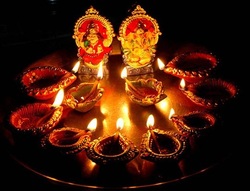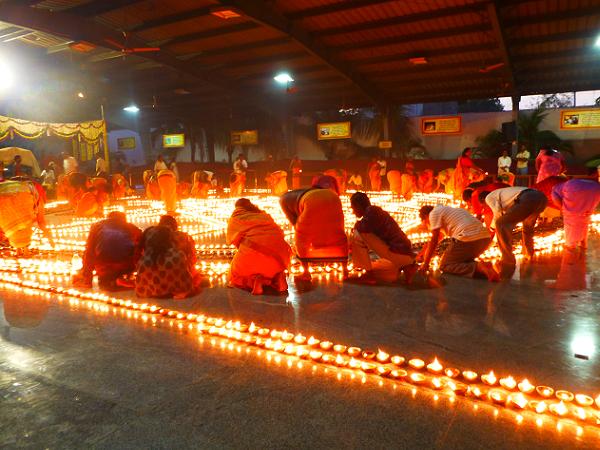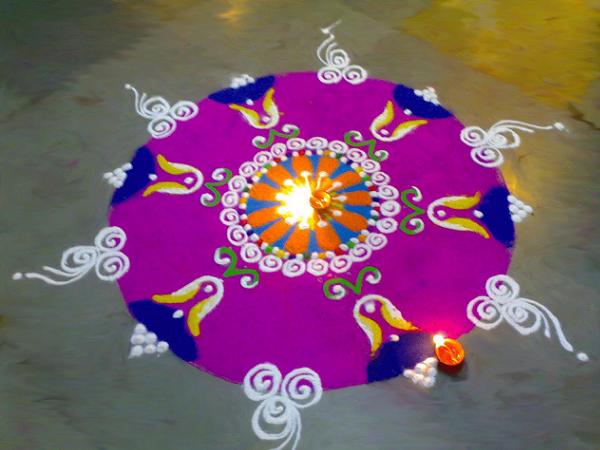
Famously known as “Festival of Lights”, Diwali is perhaps the most popular and most anticipated Hindu festival of the year. It is actively celebrated not only in India but also in multiple Asian countries like Nepal and Malaysia as well as other parts of the world. Diwali is short for Deepavali which comes from two Sanskrit words, “deepa” meaning lamps, and “vali” meaning rows. Literally translated, Deepavali means “row of lamps”. On Diwali, people decorate their homes with clay lamps known as “diyas”.
The festival is runs for five days and is celebrated by everyone regardless of their religion. However, the Diwali festival is interpreted differently depending on where you live and your faith. But one understanding is common though: Diwali is the time to celebrate the triumph of good over evil. It is a symbol of the victory of light over darkness, of truth over falsehood. It is also a holiday for loved ones to get together and exchange gifts and sweets. Diwali, simply put, is a festival of joy and color.
The festival is runs for five days and is celebrated by everyone regardless of their religion. However, the Diwali festival is interpreted differently depending on where you live and your faith. But one understanding is common though: Diwali is the time to celebrate the triumph of good over evil. It is a symbol of the victory of light over darkness, of truth over falsehood. It is also a holiday for loved ones to get together and exchange gifts and sweets. Diwali, simply put, is a festival of joy and color.
Diwali Celebrations in Different Parts of India
Diwali is a well-known Indian festival that signifies and is celebrated for different things based on religion and region in India.
In North India, Diwali celebrates the homecoming of Lord Rama to his kingdom after defeating Ravana. This day also marks Rama’s crowning as king.
In South India and Nepal, the festival commemorates Lord Krishna’s victory over the demon Narakasura.
In West India, Diwali celebrates the day Lord Vishnu delivered King Bali the demon to rule patala, the netherworld.
The people of Gujarat, a state in western India, celebrates Diwali in honor of the goddess of wealth, Lakshmi.
Bengal associates the Diwali festival with the goddess Kali, the powerful goddess of Time and Change.
Non-Hindus also have different interpretations of Diwali. For Sikhs, Diwali signifies the day the Sixth Sikh Guru, Guru Hargobind Ji, was released from imprisonment. For Jains, it is the day of Lord Mahavira’s spiritual awakening or nirvana.
Diwali is a well-known Indian festival that signifies and is celebrated for different things based on religion and region in India.
In North India, Diwali celebrates the homecoming of Lord Rama to his kingdom after defeating Ravana. This day also marks Rama’s crowning as king.
In South India and Nepal, the festival commemorates Lord Krishna’s victory over the demon Narakasura.
In West India, Diwali celebrates the day Lord Vishnu delivered King Bali the demon to rule patala, the netherworld.
The people of Gujarat, a state in western India, celebrates Diwali in honor of the goddess of wealth, Lakshmi.
Bengal associates the Diwali festival with the goddess Kali, the powerful goddess of Time and Change.
Non-Hindus also have different interpretations of Diwali. For Sikhs, Diwali signifies the day the Sixth Sikh Guru, Guru Hargobind Ji, was released from imprisonment. For Jains, it is the day of Lord Mahavira’s spiritual awakening or nirvana.

Image from : http://lakshmilovestoshop.com/
Diwali Dates
Now, if you’re looking forward for Diwali dates in upcoming years, I’ve came up with an idea of listing when Diwali festival will be in the next five years.
When is Diwali 2013: November 3, 2013
When is Diwali 2014: October 23, 2014
When is Diwali 2015: November 11, 2015
When is Diwali 2016: October 30, 2016
When is Diwali 2017: October 19, 2016
Diwali 2013: Five Days of Diwali
Of all the festivals in India, Diwali is considered to be the most exciting and the most beautiful. Homes and public places are decorated with lamps (diyas) that, when lit at night, transforms the city into a fantastic world of dazzling lights. Sweets and gifts are handed out. The skies are lit with firecrackers. There are five days of Diwali:
· Dhanteras – Or Dhanvantari Triodasi, is the first day of Diwali. “Dhan” means wealth. This is a day to worship the Goddess Laxmi for a prosperous year. Buying gold or silver or one or two utensils on Dhanteras is considered lucky. The Lord of Death, Yama Raj, should also be worshipped and given offerings on this day.
· Narak Chaturdasi – The second day of Diwali. Fewer lights are lit and fewer firecrackers are set afire. Religious rituals are performed to Goddess Lakshmi and also to Rama. Colorful rangolis with tiny footprints are made in the doorway and courtyard. It is said that one should relieve himself from stress with massages and baths on Narak Chaturdasi.
· Lakshmi-Puja – The third day of Diwali. People cleanse themselves on this day. It is a time to be with one’s family to worship the Goddess Lakshmi.
· Padwa and Govardhan Puja – The fourth day of Diwali. This day is considered to be the day Lord Krishna defeated Indra.
· Bhaiduj – The fifth and last day of Diwali. Brothers visit their sisters and they express their love and affection for each other, just as the Lord of Death, Yama, visited his sister Yami on this day.
Diwali Gift Ideas
It is a tradition to give gifts on Diwali. Gifts are given as tokens of affection and appreciation. They are also to wish for good luck and fortune. Precious metals like gold and silver are great gifts to receive on Diwali because these metals are believed to be indications of fortune. Sweets and new clothes are exchanged, as well as jewelry for women. Puja thali and diyas are also auspicious gifts. Other gift ideas to give on Diwali are deity idols, diwali books, candles, sarees, sweets and gift baskets.
Now, if you’re looking forward for Diwali dates in upcoming years, I’ve came up with an idea of listing when Diwali festival will be in the next five years.
When is Diwali 2013: November 3, 2013
When is Diwali 2014: October 23, 2014
When is Diwali 2015: November 11, 2015
When is Diwali 2016: October 30, 2016
When is Diwali 2017: October 19, 2016
Diwali 2013: Five Days of Diwali
Of all the festivals in India, Diwali is considered to be the most exciting and the most beautiful. Homes and public places are decorated with lamps (diyas) that, when lit at night, transforms the city into a fantastic world of dazzling lights. Sweets and gifts are handed out. The skies are lit with firecrackers. There are five days of Diwali:
· Dhanteras – Or Dhanvantari Triodasi, is the first day of Diwali. “Dhan” means wealth. This is a day to worship the Goddess Laxmi for a prosperous year. Buying gold or silver or one or two utensils on Dhanteras is considered lucky. The Lord of Death, Yama Raj, should also be worshipped and given offerings on this day.
· Narak Chaturdasi – The second day of Diwali. Fewer lights are lit and fewer firecrackers are set afire. Religious rituals are performed to Goddess Lakshmi and also to Rama. Colorful rangolis with tiny footprints are made in the doorway and courtyard. It is said that one should relieve himself from stress with massages and baths on Narak Chaturdasi.
· Lakshmi-Puja – The third day of Diwali. People cleanse themselves on this day. It is a time to be with one’s family to worship the Goddess Lakshmi.
· Padwa and Govardhan Puja – The fourth day of Diwali. This day is considered to be the day Lord Krishna defeated Indra.
· Bhaiduj – The fifth and last day of Diwali. Brothers visit their sisters and they express their love and affection for each other, just as the Lord of Death, Yama, visited his sister Yami on this day.
Diwali Gift Ideas
It is a tradition to give gifts on Diwali. Gifts are given as tokens of affection and appreciation. They are also to wish for good luck and fortune. Precious metals like gold and silver are great gifts to receive on Diwali because these metals are believed to be indications of fortune. Sweets and new clothes are exchanged, as well as jewelry for women. Puja thali and diyas are also auspicious gifts. Other gift ideas to give on Diwali are deity idols, diwali books, candles, sarees, sweets and gift baskets.
Diwali Rangoli
Rangoli are brightly colored folk art painted on living rooms and courtyards that are meant to welcome sacred deities. On Diwali, it is believed that the Goddess Lakshmi visit people’s homes. Hindus consider rangoli as an invitation for god or declaring god's presence in that home. You can find lot of wonderful Rangoli designs for diwali on internet.The painting of rangoli is traditionally done by women on the second day of Diwali and the pattern and color are different for each region in India. Rangoli is also believed to bring fortune.
Diwali Celebrations in a Glance
Diwali Greetings
people send diwali cards to relatives and friends. you can find lot of Diwali greetings on internet. Once you select the card, you can add some interesting diwali messages to wish them Happy diwali. Olden Days there was plenty of diwali cards were available at market. Now it has been reduced as online card sites are taken over the job of sending diwali wishes Diwali Games
On this festive occasion, games are perfect for setting the energetic and vibrant atmosphere, especially to the children. Fireworks competitions are not only fun but will also treat everyone to a beautiful display of light and colors. Musical chairs, a simple but popular game, is a fun and hilarious game to play too. And Diwali drawing contests will be a test of creativity and knowledge of the holiday.
Diwali Decorations
It is integral for the people who celebrate Diwali to not only clean their houses but also decorate them as well.Diwali decorations give the house a more festive look but they are also used to welcome the deities that enter their homes. They also bring good luck to the house and its residents. A few examples of common Diwali decorations are the diyas, sculptures of idols, Diwali candles, lanterns, door hangings (Torans), and wall hangings.
Diwali Diyas
Diyas are a crucial part of Diwali. They are clay oil lamps lit specifically during Diwali. The lighting of diyas gave the festival its celebrated title, the Festival of Lights. The lights represent one of Diwali’s essential messages, that light has overcome darkness, good triumphs over evil. Diyas come in multiple shapes and sizes that will depend on their application.
Diwali Sweets
Diwali isn’t complete without sweets. During this festival, it is customary to distribute sweets to your loved ones and neighbors. Receiving sweet treats is one of the many reasons why people absolutely love Diwali. Chocolate Khoya Kalakand, Rasmalai, Besan Ladoo, and Papaya Burfi are just a few examples of the delectable treats that are perfect for Diwali.
people send diwali cards to relatives and friends. you can find lot of Diwali greetings on internet. Once you select the card, you can add some interesting diwali messages to wish them Happy diwali. Olden Days there was plenty of diwali cards were available at market. Now it has been reduced as online card sites are taken over the job of sending diwali wishes Diwali Games
On this festive occasion, games are perfect for setting the energetic and vibrant atmosphere, especially to the children. Fireworks competitions are not only fun but will also treat everyone to a beautiful display of light and colors. Musical chairs, a simple but popular game, is a fun and hilarious game to play too. And Diwali drawing contests will be a test of creativity and knowledge of the holiday.
Diwali Decorations
It is integral for the people who celebrate Diwali to not only clean their houses but also decorate them as well.Diwali decorations give the house a more festive look but they are also used to welcome the deities that enter their homes. They also bring good luck to the house and its residents. A few examples of common Diwali decorations are the diyas, sculptures of idols, Diwali candles, lanterns, door hangings (Torans), and wall hangings.
Diwali Diyas
Diyas are a crucial part of Diwali. They are clay oil lamps lit specifically during Diwali. The lighting of diyas gave the festival its celebrated title, the Festival of Lights. The lights represent one of Diwali’s essential messages, that light has overcome darkness, good triumphs over evil. Diyas come in multiple shapes and sizes that will depend on their application.
Diwali Sweets
Diwali isn’t complete without sweets. During this festival, it is customary to distribute sweets to your loved ones and neighbors. Receiving sweet treats is one of the many reasons why people absolutely love Diwali. Chocolate Khoya Kalakand, Rasmalai, Besan Ladoo, and Papaya Burfi are just a few examples of the delectable treats that are perfect for Diwali.

 RSS Feed
RSS Feed